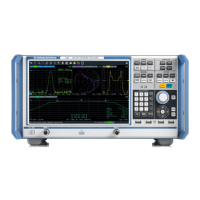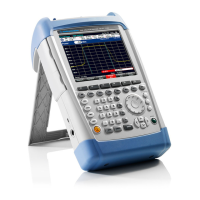Performing Configuration Tasks
R&S
®
SGS100A
153User Manual 1173.9105.02 ─ 12
3. In the "Reference Oscillator" dialog, set the parameter "Ext. Ref. Input Frequency"
to the value of the fed external reference frequency.
Now, the instrument uses an external reference signal. The green [REF EXT] LED
at the front panel of the instrument indicates that the instrument is synchronized to
the external reference signal.
If the instrument is configured to use an external reference signal but no signal is fed in
at the REF/LO IN connector, the [REF EXT] LED on the front panel of the instrument is
red and an error message is displayed in the "Info" line.
9.5 How to Configure the Local Oscillator (LO) Coupling
Source
The R&S SGS can use two frequency sources for the carrier frequency (LO signal) of
the I/Q modulator, an internal and an external one. The first possibility is to use the out-
put signal of the internal synthesizer. If an external LO signal is provided at the REF/
LO IN connector, this signal can alternatively be directly routed to the LO input of the
I/Q modulator.
To use an external LO source
1. Provide the signal of an external LO source to the REF/LO IN connector of the
instrument.
Note: The local oscillator input/output requires the additional software option
R&S SGS-K90.
2. Select "SGMA-GUI > Instrument Name > Frequency/Phase > LO Coupling Source
> Ext".
Tip: When you select "Source > Ext", the icon LO Scr Ext appears in the
R&S SGMA-GUI.
The signal provided by the external frequency source is directly routed to the input
of the I/Q modulator and used as carrier frequency.
To use the internal LO source
► Select "SGMA-GUI > Instrument Name > Frequency/Phase > LO Coupling Source
> Int".
The output signal of the internal synthesizer is used.
How to Configure the Local Oscillator (LO) Coupling Source

